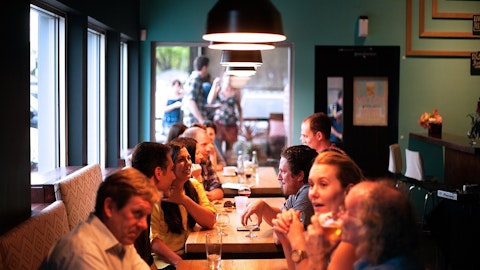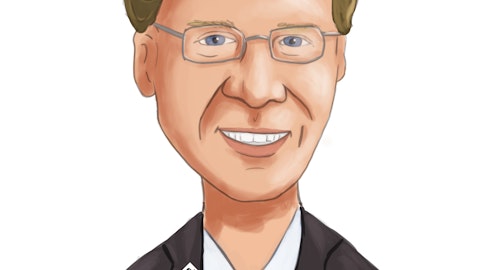Operator: Your next question comes from Todd Brooks with Benchmark Company.
Todd Brooks: Quick question, not much left to ask. But you talked about, Steve, you referred to kind of the June, July trends and I think they were — Jon, you might have sized them in the 2% to 3% range, which with the pricing roll-off is very impressive for the July result. I’m just wondering with your geographic footprint is crushing heat, have you been able to use the patios to the full extent that you normally would seasonally in the summertime? And do you have a sense of maybe — is there actually a stronger underlying demand at just this brutal heats keeping from being able to use the restaurant?
Steven Hislop: Yes. It’s been a while, but is that really exactly — I think if you remember a year ago at this time, we talked about the 60-something days of over 100, and we’re just again. So it’s very similar to a year ago. And yes, it definitely affects in Texas, obviously, and elsewhere, definitely some of the patio sales, no one’s sitting out in the patio at 100 degrees. So that’s definitely an effect. But like I said, it’s very similar to a year ago at this particular time.
Operator: Our next question comes from Nick Setyan with Wedbush Securities.
Nerses Setyan: In terms of the commodity inflation, I appreciate the Q2 disclosure around down 4%. What’s — and I’m sorry if I missed this, but what’s the Q3 expectation, the Q4 expectation. Or maybe a better way to ask it is sequentially versus Q2, are we kind of flattish in terms of basket is? Or are we continuing to see it go down?
Jon Howie: I think it’s flattening now. I mean if you’re looking like over last year, we’re looking — I think we said low single-digit deflation for the third quarter. We look something similar to that to flat deflation in the back half and the fourth quarter, which gets us to basically flattish for the year is kind of how we’re looking at it right now.
Nerses Setyan: And so, just given the math on the lower pricing and that the inflation is sort of a mid-25% COGS. Is the right way to think about Q3? Because it just seems like there will be a big jump from Q2.
Jon Howie: Yes. It’s kind of — that’s kind of what we’re looking at.
Nerses Setyan: Okay. Okay. And in terms of just Q3, Q4 unit-level margins, historically, Q4 is a little bit lower, but we have the extra week. So I mean, do they end up being a little bit closer to each other, both of them may be in the sort of high 17% range?
Jon Howie: Come back again on the unit level margins. Is that what you’re saying for Q4?
Nerses Setyan: Q4 tends to be lower than Q3 historically. But given that for extra week, does that kind of help it come up closer to Q3 this year?
Jon Howie: Yes. It actually increased it a little bit over Q3.
Operator: Our next question comes from Andy Barish with Jefferies.
Andrew Barish: Wondering if you can give us an update on sort of dining room traffic versus pre-COVID. I know there’s been some big changes in seating and hours. But just trying to level set on that. And do you see that as an opportunity, just given some of the shifting consumer behavior out there?
Jon Howie: Well, again, with our addition of our other delivery service and that increasing from a percentage of sales, our dine-in sales are still right from a traffic standpoint, still at about 75% to 80% of what they were prior to the pandemic and then we’ve been pretty consistent with that. As you know, we still have taken some of those seats out and we haven’t put those back in, just from a productivity standpoint. And also the hours, we haven’t brought those hours back either. Those — we’ve deemed that those haven’t been very profitable hours as well. So yes, we’re still at that 75% to 80% in traffic from a dine-in perspective, but our off-premise has grown a little bit.
Andrew Barish: Okay. And then on the marketing side, I know you’re up back up to about 1.5% or so of sales. Is there any new channels or waiting kind of that you’re looking at for that media spend?
Steven Hislop: Yes. Right now, we’re pretty happy with that percent. And as things change, we’re obviously looking at everything. We’re doing a little bit — I mentioned a few during the — my prepared statement, but a couple of other things that are fairly new is programmatic, TV, and we’re doing a lot of stuff with Yelp and so on, on top of that. But we’re always looking at things and redistributing, but we’re pretty pleased with all the mediums that we’re using.
Andrew Barish: Okay. And a few years back, I mean, again, pre-pandemic, you guys were doing outdoor, which seems to have some effectiveness in highlighting kind of the core values, anything along those lines in certain markets or just keeping it balanced?


